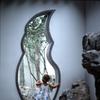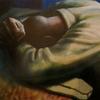The Birmingham Museum of Art Premiers The Look of Love
- BIRMINGHAM, Alabama
- /
- February 07, 2012
The Birmingham Museum of Art debuts The Look of Love: Eye Miniatures from the Skier Collection, the first major exhibition of lover's eye jewelry, on display from February 7, 2012 to June 10, 2012.
Exquisite in craftsmanship, unique in detail, and few in number, lover's eye miniatures are small-scale portraits of individual eyes set into various forms of jewelry from late 18th- and early 19th-century England. Featuring an impressive 98 pieces, the collection is considered to be the largest of its kind, with only 1,000 lover's eye miniatures thought to be in existence worldwide. Part of a trend that began with Britain's Prince of Wales (later George IV), clandestine lovers exchanged these customized tokens depicting one another's eyes, as such a feature might only be recognized by persons of the most intimate familiarity. Thus, behind the skilled artistry with which each of these tiny portraits was painted, lie the enchanting stories of secret romance and love lost, which inspired the creation of this popular, albeit short-lived fashion.
Dr. Graham C. Boettcher, The William C. Hulsey Curator of American Art at the Birmingham Museum of Art, organized The Look of Love with the participation of collectors, Dr. David and Mrs. Nan Skier of Birmingham.
“We are delighted to present the largest ever exhibition of these intriguing and enigmatic objects, which are sure to delight the viewer with their beauty, intricacy, and mystery,” says Boettcher.
A Secret Affair
The genesis of lover’s eyes is a story of forbidden love. In 1784, the 21-year-old Prince of Wales became smitten with Mrs. Maria Fitzherbert, a Catholic widow. Under the Royal Marriage Act, the Prince could not marry without his father’s consent until the age of 25, and it was highly unlikely that King George III would agree to the heir to the throne marrying a Catholic widow. Mrs. Fitzherbert initially rebuffed the Prince’s advances, but after he staged a suicide attempt to demonstrate his despair, she gave in and accepted his proposal. The following day, she came to her senses and fled to the Continent, remaining there for more than a year. She hoped that her absence would quell the Prince’s feelings, but true to the old adage, it only made his heart grow fonder. On November 3, 1785, the Prince wrote to Mrs. Fitzherbert with a second proposal of marriage. Instead of sending an engagement ring, he sent her a picture of his own eye, painted by the miniaturist Richard Cosway, writing, “P.S. I send you a Parcel…and I send you at the same time an Eye, if you have not totally forgotten the whole countenance. I think the likeness will strike you.” Shortly thereafter, Mrs. Fitzherbert returned to England and married the Prince in a secret ceremony on December 15, 1785. Not long after their clandestine nuptials, Mrs. Fitzherbert (as she preferred to remain) commissioned Cosway to paint a miniature of her own eye for the Prince. The Prince of Wales’ token of affection inspired an aristocratic trend for exchanging eye portraits mounted in a wide variety of settings lasting the next few decades.
About the Exhibition
Struck by the splendor of an elegant ring featuring a lover's eye portrait, Nan and David Skier began their eye miniature collection with this solitary purchase in 1993 at an antiques show. Over the past several years, they have quietly built the largest collection of lover's eye miniatures in the world.
“These rarities are at once works of art, precious jewels, and fragments of history. How poignant it is that each eye represents an actual person and an actual story of a long-ago love or bereavement, now lost to the passage of time,” says Mrs. Skier.
The collection now contains an incredible array of 98 objects, both decorative and functional, from simple lockets to lavish rings, as well as watch keys and toothpick cases, each of which features an eye miniature. While the majority of the pieces were meant to be worn as jewelry, mainly brooches and pendants, some were intended to be carried on one’s person in the form of small boxes. Each object from the collection will be on display in remarkable installation cases in the Arrington gallery. Admission to the exhibition is free of charge.
Related Materials and Programs
The exhibition will be accompanied by a scholarly catalogue of the entire collection edited by Boettcher, with contributions by Elle Shushan, Jo Manning and Boettcher, himself. The catalogue will feature full-color images of the lover's eye pieces. Published by D. Giles Limited, the catalog will be available for sale in the Museum store ($35, hardcover).
The Birmingham Museum of Art will present a related event, Trinket or Treasure, a day of jewelry appraisal featuring Gloria Lieberman, Vice President of Skinner Auctions of Boston on Saturday, February 25. One of the world's renowned experts on antique jewelry, Ms. Lieberman founded Skinner's Fine Jewelry Department in 1980 and served as director for 31 years. Her skillful marketing and management of the department resulted in the achievement of international world record prices for estate and heirloom jewelry, gaining valuable recognition for Skinner. Appraisals will be held between 10 a.m and 12 p.m. and again between 1 p.m. and 4 p.m. Ms. Lieberman will deliver a public lecture at 12 p.m. Participants will pay a fee of $25 for up to two objects and $20 for each additional object.
About the Birmingham Museum of Art: Founded in 1951, the Birmingham Museum of Art has one of the finest collections in the Southeast. More than 24,000 objects displayed and housed within the Museum represent a rich panorama of cultures, including Asian, European, American, African, Pre-Columbian, and Native American. Highlights include the Museum’s collection of Asian art, Vietnamese ceramics, the Kress collection of Renaissance and Baroque paintings, sculpture, and decorative arts from the late 13th century to the 1750s, and the Museum’s world-renowned collection of Wedgwood, the largest outside of England.
















